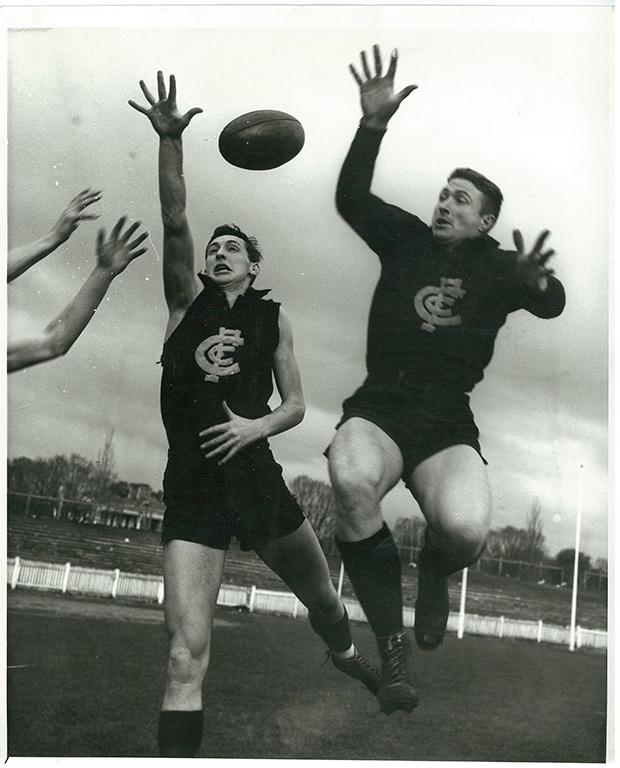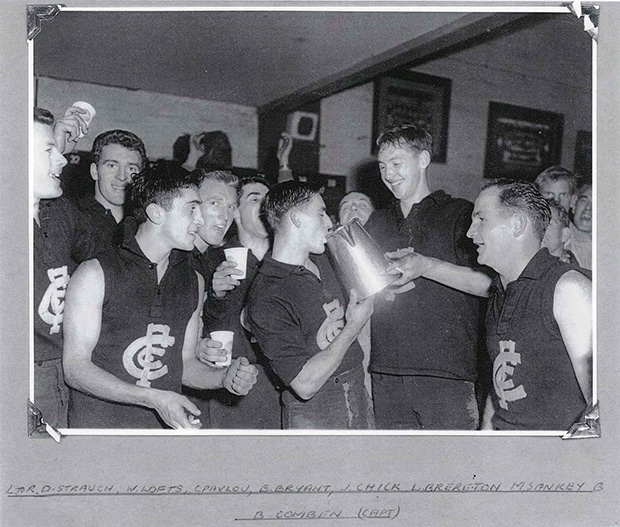A young cowboy named Billy Joe grew restless on the farm
A boy filled with wanderlust who really meant no harm
He changed his clothes and shined his boots
And combed his dark hair down
And his mother cried as he walked out
Don’t take your guns to town son
Leave your guns at home Bill
Don’t take your guns to town
As the 50th anniversary of the tragic death of former Carlton ruckman Maurie Sankey nears, the words of the classic Johnny Cash ballad still resonate with Sankey’s old teammate Gordon Collis.
For the 1964 Brownlow Medallist, the old folksong offers a throwback to happy times when he, Sankey and John Reilly roomed at 19 Berry Street, Coburg - a “Percy” Jones tram ride from Princes Park where the three young men once chased the leather.
“The place was adjacent to an old army type of set-up. It was run by an old lady named ‘Vonny’ (Veronica) Curtin,” Collis recently recalled.
“Vonny was born in 1900 and was a dyed-in-the-wool Carlton person. She owned the place and a series of people passed through there. I know that Dave McCulloch was there for a while and Wes Lofts used to come around to play cards.”
Even after all these years, thoughts of Sankey and Berry Street are never far from Collis’ mind – as was the case when he and his wife recently tuned in to an episode of ‘The X Factor’.
“There was a girl on it who sang ‘Bang Bang’ and when she finished I said to Anne ‘This girl reminds me of Sankey’,” Collis said.
“In 1960 or ’61 when we were living at Berry Street, there was an idea put forward by the VFL or perhaps one of the commercial television channels that the clubs put up someone to belt out a number on the box. Now I got to know a couple of people who lived almost directly across the road who had a daughter who was a pianist, so I promoted this idea to Maurice that he should give a song a go to piano accompaniment.
“Sure enough we got him to the post. We had some rehearsals over the road and I suggested to him that he ought to sing this particular song that suited him, which was Don’t Take Your Guns To Town.
“Anyway he turned up to the studio in all the clobber, even down to the leather chaps. The song was recorded, but I don’t know if the recording’s still in existence.”
The Tasmanian-born Maurice Graham Sankey was recruited to Carlton from the Latrobe Football Club on the cusp of the 1959 season.
Berkley Cox remembered Maurie from the old days on the Apple Isle. Cox, who celebrated his 80th birthday in May, vouched for the Sankey sporting pedigree in declaring Maurie’s father Joe an outstanding cricketer and footballer.
Awarded Carlton Life Membership for eight years’ service and named Best Clubman in Sankey’s final season of ’65 season, Cox regarded his old friend as “a great player, a top bloke and a terrific team man”.
“Maurie played for Latrobe and I played for City. I played against him in those days of the NTFA, NWFU and the TFL, and I also played with him at Carlton,” Cox said.
As with Collis, Cox shared digs with the free-spirited Maurie for a time.
“We lived in a house in Melbourne with another friend of ours who’s passed away called Allan Wilson. It was called ‘The Tasmanian Embassy’ because all the Tassie players who used to come over went there,” Cox said.
“There were a few blokes over from Tassie at the time - Maurie, John Heathcote, Johnny Chick and myself.
“One thing I remember is that when we had to move out of the flat in Coburg we had to get rid of the empty bottles (longnecks) – and when the chap came to collect them he said he’d never seen so many. He said ‘Do you mind if I ring The Herald?’, to which we replied ‘You better not’.”
Maurie’s cavalier attitude to life was borne out in his footy. To steal an old expression, the player sailed closed to the wind - which endeared him no end to the dark Navy Blue faithful.
Collis, Carlton’s No.17 who shared lockers with Maurie at 16, can personally vouch for the fact that his old pal never exhibited any fear.

Maurie Sankey and the legendary John Nicholls, circa 1960. (Photo: Carlton Football Club)
“Before I started playing I can remember that Maurice came on to the ground in a finals match, not sure who the club was playing, as a 19th or 20th man. He ran around clobbering a couple of blokes and really sparked the team doing it,” Collis said.
“But you couldn’t say he was always judicious with his activities – I can remember playing against Essendon and I had Ken Fraser, who was such a fair player, pretty well under control. Anyway, the ball was in our forward line and for some unknown reason Sankey decided to wrestle Fraser to the ground – and the avalanche that this caused was incredible.
“I found myself ducking and weaving blokes like Don McKenzie who could fire up and we had a comfortable lead, so Maurice’s actions were totally unnecessary and we ended up losing by as much as we were leading at that stage.”
Through his seven seasons at Princes Park, Maurie earned his keep as an acknowledged tap ruckman. Forming part of an accomplished following division comprising John Nicholls, Ken Greenwood, Sergio Silvagni, Graham Donaldson and the late Brian Buckley – Maurie was amongst the big six famously photographed for posterity at a Princes Park training session in 1960.
“He was a bit of an unusual build. He tended to be a little pear-shaped,” Collis said of Maurie.
“He was always pretty strong around the hips and thighs, but he tapered off up top. But typical of his determination he set about rectifying that and he built himself up into a really good physical specimen.
“He applied himself and it made a really big difference to his play. He started taking a lot of marks around the ground simply because he had that strength to stand tall and take them.”
Through the gruelling finals series of ’62 (brought on by the tied Prelim against Geelong), Maurie was a standout for his team. Such was the respect he commanded amongst the ranks that by ’64 he was named vice-captain to Silvagni, and with the emergence of the team under the great Ronald Dale, Maurie’s future seemed assured.

Maurie Sankey (second from right) celebrates a win with his Carlton teammates, circa 1960. (Photo: Carlton Football Club)
Who was to know that when Maurie turned out for his 100th senior appearance (against Richmond in the 17th round of 1965), this would be his last.
On the evening of Sunday, November 21, 1965, Maurie was killed when the car in which he was driving was involved in a head-on collision on the Hume Highway, five kilometres north of Wangaratta.
According to a report in The Canberra Times of Tuesday, November 23, Maurie was one of three young men to have lost their lives.
The story goes that Maurie, then employed with the Beneficial Finance Company, was ferrying three workmates back from Wagga Wagga after they had competed in a golf tournament.
Those three men escaped serious injury, but the two occupants of the other car, who were heading home to New South Wales after the Sandown car races, got trapped in the chassis when it burst into flames on impact.
“I remember when he got killed that he had been out playing golf,” Cox recalled.
“He was behind the wheel of a car when he tried to pass a truck going up a hill. When he got to that truck he suddenly found another truck in front of it. He went to pass the second truck when he realised a car was coming the other way, so he veered right, but the oncoming car veered left and that was the finish of him.”
Collis, then domiciled at 19 Berry Street, was one of the first advised about the unmitigated tragedy. Said Collis: “We had the cops come to the door and tell us the news. It was one hell of a shock”.
Carlton players and officials bid farewell to Maurie, who left behind a partner and four month-old son, at a funeral service held at the Brunswick Baptist Church on Sydney Road. Following the service, the cortege paused for a moment by the old Princes Park ground en route to Springvale Cemetery where in grave 01, Row F on the HN Featonby Lawn the young ruckman was laid to rest.
Today, some 50 years after his untimely demise, Maurie’s loss is still deeply felt.
“It’s hard to quantify, but I still think of him now,” Collis said.
“Maurice wasn’t one of those blokes you’d forget. In different ways his memory surfaces and I even have a pin number which includes his jumper number to help me remember.
“He was dedicated to the game all right. He wasn’t a pretend player and he hadn’t hit his prime either. He was just reaching the peak of his powers.
“He was a terrific bloke. You could almost classify him as the most popular bloke at the club really. He had a daredevil sort of approach to life. He personified courage, although you can get courage mixed up with foolhardiness at times and he might have had a mix of that. In fact it might have led to his demise too.”
It is here that Collis drew on a tale that in part tells the whole of the boy filled with wanderlust who was Maurie Sankey.
“I can remember we had a day up at Buller. None of us had been on the skis and we were going pretty carefully, but not Maurice. He threw caution to the wind and whatever happened down below happened,” Collis said.
“He was inclined to be a risk taker. I might be totally wrong, but this is the thought that has stayed with me forever, from the time I first heard that it happened.”


